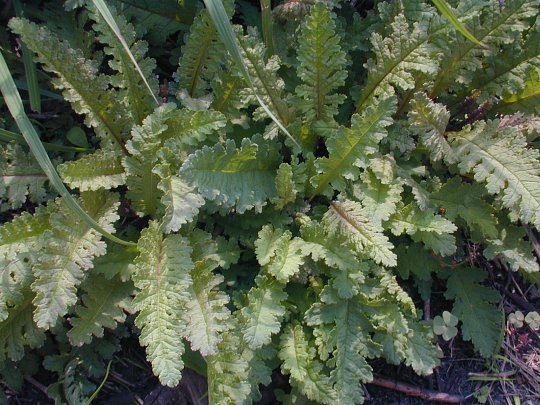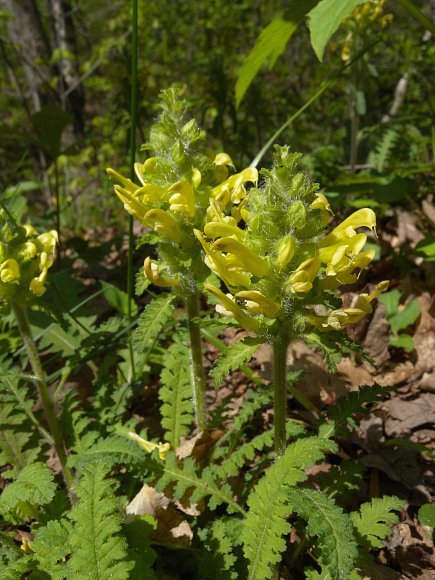Description: This perennial plant is ½–1' tall and unbranched. The foliage consists primarily of basal leaves up to 6" long and 2" across, which are arranged as a rosette. From the center of this rosette, emerges a stout flowering stalk, which is often covered with long white hairs. The stalk itself may be green or reddish brown. There are a few small leaves that alternate along this stem. The leaves are lanceolate or oblanceolate, with angular pinnate lobes and crenate margins. The margins have a tendency to undulate vertically. These characteristics provide the leaves with an almost fern-like appearance, except they are somewhat heavier and thicker.

The flowers occur
along a spike at the top of the stem. They are about ¾" long and
tubular with two lips. The upper lip curves downward and functions as a
protective hood, while the lower lip functions as a landing pad for
insects. The flowers are usually yellow, but sometimes brownish red.
The lower lip of the flower is often white. These flowers bloom from
the bottom up during late spring; this blooming period lasts about 3
weeks. There is a mild floral fragrance that is not always detectable
to the human nose, although bees and other insects can detect it. The
flowers are replaced by large fruits that are angular and hairy. The
root system consists of a taproot, and lateral roots that are parasitic
on the roots of grasses and possibly other plants. Wood Betony,
however, is capable of normal growth and development even when suitable
host plants are unavailable. This plant often forms colonies by
reseeding itself.
Cultivation:
The preference is partial to full sun, mesic to dry conditions, and a
somewhat acidic soil, which can be loamy or sandy. Most of the growth
and development of this plant occurs during the spring, although the
leaves stay green during the summer.

Range &
Habitat:
The native Woody Betony occurs occasionally in the northern half of
Illinois, but
it is uncommon or absent in the southern half of Illinois (see Distribution
Map). Habitats include mesic to dry black soil prairies, open
woodlands and sandy woodlands, savannas and sandy savannas, thickets,
and borders of lakes. This plant is often associated with the Black Oak
in woodlands and savannas. Because of its parasitic habit, there is a
tendency for the surrounding grass to be shorter in height than it
would be normally, creating open areas along the ground where colonies
of Wood Betony occur.
Faunal Associations:
Long-tongued bees are the primary visitors of the flowers, including
queen bumblebees and Mason bees. Occasionally, short-tongued Halictid
bees may visit the flowers to collect pollen, but they are
non-pollinating. Little information is available about this plant's
relationship to birds and mammalian herbivores.

Photographic
Location:
The photographs were taken at a meadow of Orchid Hill in Vermilion
County, Illinois, the Prospect Cemetery Prairie in Ford County,
Illinois, and a rocky woodland of the Potholes in west-central
Indiana.
Comments:
Wood Betony is very showy when it is in full bloom. Because of the
unusual
flowers and foliage, it has a striking appearance. There are other Pedicularis
spp. that this
plant resembles, however most of them don't occur in Illinois. An
exception is Pedicularis lanceolata
(Swamp Betony), which differs from Wood Betony by its greater height,
leaves with shallower pinnate lobes, and preference for wetland
habitats. The flowers of these two plants are very similar. Another
common name for this plant is Lousewort, which was based on the
mistaken belief that it could repel lice and similar parasites from
livestock.